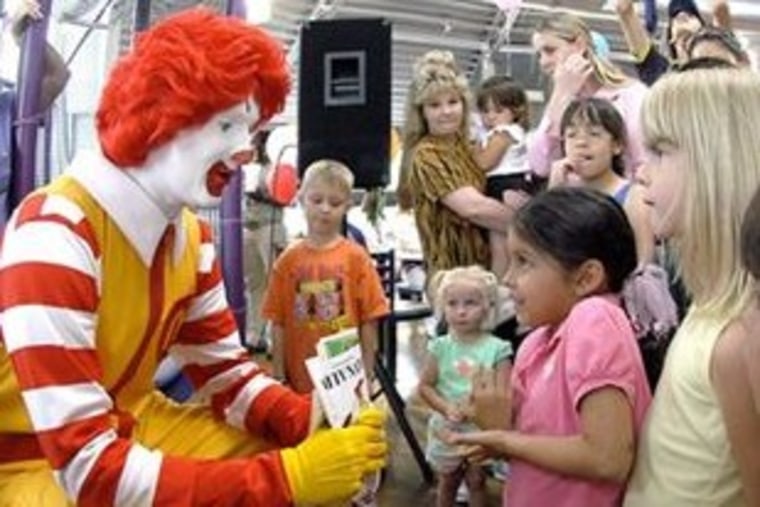Ronald McDonald is having a midlife crisis.
His floppy shoes, painted-on smile and flaming-red hair may be a harder sell to today's kids who are trading in their dolls and trucks for manicures and mobile game apps at ever younger ages. He also seems out of step with McDonald's Corp.'s new efforts to appeal to adults. The 48-year-old spokesclown has fallen flat in new ads this year, according to Ace Metrix, a group that tracks TV advertising.
And the government is getting strict on marketing unhealthy food to children. That has both marginalized Ronald as more of a mascot than a product pitchman and landed him in the middle of the bigger debate about food makers' responsibilities in stemming the rise in childhood obesity.
McDonald's says it is proud of the food it offers and that Ronald teaches children to be active.
Critics say it's time to hang up the yellow jumper.
A group called Corporate Accountability International plans to ask Ronald to retire at the company's annual meeting on Thursday. They say Ronald encourages kids to eat junk food, contributing to a rise in childhood obesity and related diseases such as diabetes.
The group, which campaigned against the Joe Camel cigarette mascot in the '90s and complained about Ronald as a role model at McDonald's annual meeting last year, has stepped up its campaign. The group has taken out full-page ads Wednesday in the Chicago Sun-Times, New York Metro and four other papers to call for his head. The ads, signed by more than 550 health groups and professionals, carry the headline, "Doctors' Orders: Stop Marketing Junk Food To Kids."
What follows is an open letter to McDonald's CEO Jim Skinner, that says in part, "We ask that you heed our concern and retire your marketing promotions for food high in salt, fat, sugar, and calories to children, whatever form they take — from Ronald McDonald to toy giveaways."
McDonald's defended Ronald against the group's attack at last year's annual meeting and is adamant that it has never considered retiring or even downplaying their smiling mascot.
"It's totally unfounded," said Marlena Peleo-Lazar, the company's chief creative officer, who describes Ronald as "a force for good."
Ronald, the world's most famous clown, had humble beginnings with a paper-cup nose and scraggly blonde wig. First played by Willard Scott in 1963, he dispensed burgers and fries to delighted children and flew around on a magic hamburger. "Goofy and clumsy" is the way McDonald's describes the early incarnations.
A decade later McDonald's created standards on makeup and mannerisms for Ronald, so the actors who portrayed him could present a united front. Around that time, they also created McDonaldLand, home to Grimace, Mayor McCheese and an array of other characters.
(McDonald's, for the record, views Ronald as a real person. "There's only one Ronald," Peleo-Lazar said in response to several questions about how many actors portray the smiling clown.)
Around 2004, McDonald's christened Ronald as a "balanced, active lifestyles ambassador," and stuck him in commercials where he trained for the Olympics. He got workout clothes. He got a tuxedo. He moved from McDonaldLand into the real world. New commercials show him as an active, athletic clown who plays soccer, shoots hoops and encourages kids to visit McDonald's Happymeal.com website. There's barely a mention of burgers and fries.
While other clowns have faded, Ronald has endured. He's been immortalized as a Beanie Baby, a bobblehead and a balloon in the Macy's Thanksgiving parade. Even now, Zagat says he's the most popular fast-food mascot, beating out Jared the Subway Guy.
"It would be tough to walk away from him," said Nigel Hollis, whose company, Millward Brown Optimor, calculates that McDonald's is the fourth-most valuable brand in the world. "It would be almost as if the Geico gecko disappeared, or the Aflac duck."
But Jack McKee, vice president of sales and marketing at Ace Metrix, said new Ronald McDonald commercials have failed to entice test audiences. His company surveyed 500 people about each commercial, he said.
"It's really remarkable how often I saw the word 'creepy'" in the survey comments, McKee said.
Replies Peleo-Lazar: "For everyone who may feel that way, there are more who feel the opposite."
Through the years, Ronald has also been the face of Ronald McDonald House Charities, which provides free or inexpensive housing for families who must travel to get medical treatment for a child. He still shows up as often as ever at camps for sick children and charity events.
Nick Guroff, a spokesman for Corporate Accountability International, said while that's a worthwhile charity, "to use that as their excuse for marketing junk food to kids is sort of having their burger and eating it too."
